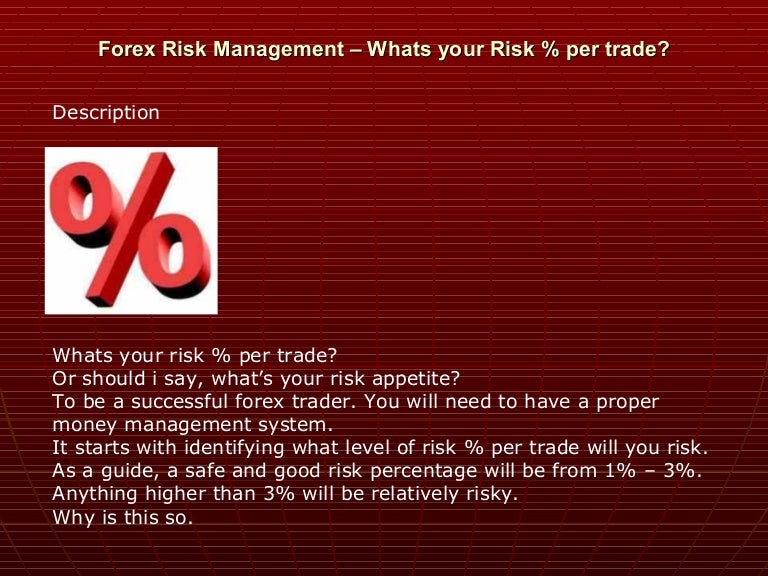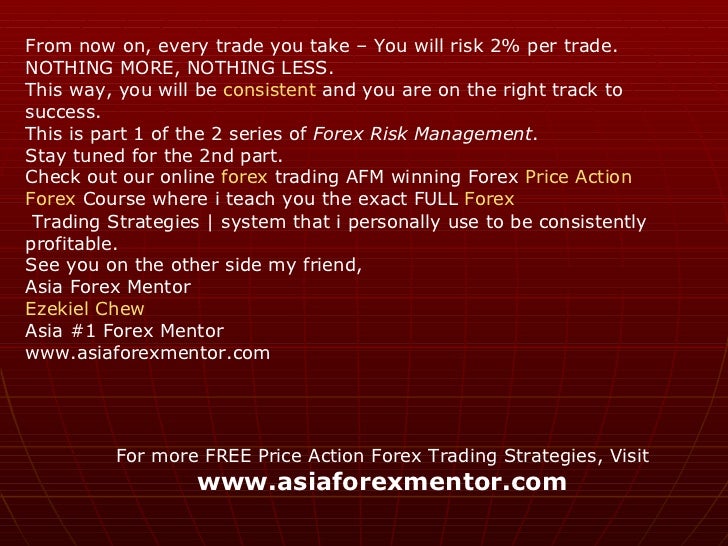
Risk management can then be defined as a set of rules and measures you can put in place to ensure the impact of getting a decision wrong is manageable. At the end of the day, Forex is a numbers game. And in order to win, you have to tilt as many factors as you can in your favour. You want to be a part of the 1%, NOT one of the gamblers because, in The risks of trading Forex include: Country risk (e.g., ratings downgrade) Sovereign risk (e.g., asset-freezing, expropriation) Liquidity risk (no buyers if you are a seller) Credit risk (counterparty or broker fails) Price risk (price moves against you fast and without warning) You should be trading a currency that does not have a lot of country or sovereign risk — i.e., the majors 14/04/ · Essentially, this is how risk management works. If you learn how to control your losses, you will have a chance at being profitable. In the end, forex trading is a numbers game, meaning you have to tilt every little factor in your favor as much as you can
What is Risk Management in Forex? - blogger.com
You should be trading a currency that does not have a lot of country or sovereign risk — i. If you choose to trade an emerging market or frontier currency, you will have country whats risk management in forex sovereign risk — as well as liquidity risk — and once a crisis has appeared, you have almost no remedies against a crashing price. As for credit risk, whats risk management in forex, you can control credit risk to a large extent by keeping your brokerage account at a broker that whats risk management in forex adequate capital, no grievances registered at regulators for fraud or failure to perform, and probably most of all, no complaints by credible chat-room writers and bloggers.
As a day-to-day practical matter, the risk you can actually manage is price risk, whats risk management in forex. The high-end risk management industry speaks in exalted terms about identifying and mitigating risk, but for purposes of becoming a successful Forex trader, this boils down to some statistical work.
You can do a lot of it or a little of it, but you must do some. You plan to work on the H4 chart. The first question you need to ask is what is the average high-low range over a very large series of H4 chunks of time. This is not hard to do if your data source offers ATRor average true range.
The ATR varies from a low of 0. This is not a bad starting point, because now you know that per H4 period, you can expect an average of This will come in handy when you are setting stops and target.
You would consider points your risk amount. Multiply that out by the number of lots you would be trading, assuming you might hold for as long as three weeks, to find your maximum loss.
This is not something very many traders actually do, but it is certainly an interesting exercise. But it does not measure how quickly the price changes, i, whats risk management in forex. Various versions of choppiness are available. This particular one is for MetaTrader 5. Choppiness is a function of market direction, whats risk management in forex. A trending currency pair will have a low choppiness indicator value while a trendless currency pair will have a high choppiness value.
Choppiness may range between 0 and The higher the index, the choppier the rate fluctuation is. The lower the index, the more trending the market.
Since Choppiness is a look-back indicator, it has a length, which sets its look-back period. Default one is 14 candles. It is important to grasp that the Choppiness indicator is a judge of the trend, like the Average Directional Index or ADX, developed by Wells Wilder in The formulas whats risk management in forex overly complex for example, degree of directional movement is calculated by comparing the difference between two consecutive lows with the difference between the highs.
The important point is that when your price is trending, you are at less risk whats risk management in forex a surprise adverse movement. How do we interpret the data on chart above? The first thing to notice is that the Choppiness indicator rises sharply after the upside breakout move on the left side of the chart and again ahead of the downside breakout move in the center. This illustrates that when the market is moving fast, you are taking high price risk if you are in the wrong position.
If you are in the right position, of course, volatility offers opportunity. Notice that in the center of the chart, when the euro is range-trading and failing to match the previous highest high, volatility is also rising. This is like the Bollinger Bands contracting into a Squeeze. In fact, if you place Bollinger Bands on this chart, you will see the Squeeze just ahead of the downside breakout.
The important thing to take away from the Choppiness chart is that it provides a measure of volatility and therefore price risk to you. When the volatility is low, you are taking less risk. When it whats risk management in forex high, you are taking more. We have numerous other ways to measure volatility, including the conventional standard, the standard deviation, and standard error. For more on those two measures, see the lesson on Bollinger Bands and the one on Channels.
The problem with both these measures is that to see them graphed on a chart offers no insight at all and we are not showing them for this reason. Another way to get a grip on volatility is with Rate of Change, which is a simple indicator that shows the price today minus the price X periods back. You can tell whats risk management in forex charting software to display it in points or as a percentage. Generally speaking, at this point you should be thinking in terms of points.
See the chart below displaying Rate of Change for the H4 timeframe, whats risk management in forex. In this display methodology, the zero line marks where the close price of the H4 bar is unchanged from the closing price 10 periods earlier, or roughly 1. The high on the left is 1. This means that if you had bought near the highest price high and failed to exit, your loss would be on the order of 7.
As a practical matter, it is doubtful that many traders actually use ROC to analyze the riskiness of their position, but it is not altogether without value to look at it once in a while.
Bottom line, to assess your risk of loss, you need to know the minimum, maximum and average price change, and the speed of that change, over your expected holding period. It is of no use to consult percentage price change or rate of change for a whats risk management in forex holding period if your holding period is four hours or three days.
MT4 Forex Brokers MT5 Forex Brokers PayPal Brokers WebMoney Brokers Oil Trading Brokers Gold Trading Brokers Muslim-Friendly Brokers Web Browser Platform Brokers with CFD Trading ECN Brokers Skrill Brokers Neteller Brokers Bitcoin FX Brokers Cryptocurrency Forex Brokers PAMM Forex Brokers Brokers for US Traders Scalping Forex Brokers Low Spread Brokers Zero Spread Brokers Low Deposit Forex Brokers Micro Forex Brokers With Cent Accounts High Leverage Forex Brokers cTrader Forex Brokers NinjaTrader Forex Brokers UK Forex Brokers ASIC Regulated Forex Brokers Swiss Forex Brokers Canadian Forex Brokers Spread Betting Brokers New Forex Brokers Search Brokers Interviews with Brokers Forex Broker Reviews.
Forex Books for Beginners General Market Books Trading Psychology Money Management Trading Strategy Advanced Forex Trading. Forex Forum Recommended Resources Forex Newsletter. What Is Forex? Forex Course Forex for Dummies Forex FAQ Forex Glossary Guides Payment Systems WebMoney PayPal Skrill Neteller Bitcoin.
Contact Webmaster Forex Advertising Risk of Loss Terms of Service. Advertisements: RoboForex — Over 8, Stocks and ETFs. Please disable AdBlock or whitelist EarnForex. Thank you! EarnForex Education Forex Course. The risks of trading Forex include: Country risk e. Price Risk As a day-to-day practical matter, the risk you can actually manage is price risk. Measuring price risk with average true range indicator.
Measuring Volatility But it does not measure how quickly the price changes, i. Measuring price risk with Choppiness indicator. Measuring price risk with Choppiness indicator and Bollinger Bands.
Measuring price risk with Rate of Change. Quiz : 1. The biggest risk in trading Forex is. To measure price risk, you need to know, whats risk management in forex. The best way to measure volatility is with. YOUR RESULT. Trading Systems Basics Topic 01 - Manual Trading Systems. Topic 01 - Manual Trading Systems Topic 02 - Mechanical Trading Systems Topic 03 - Automated Mechanical Systems.
Risk Management Topic 01 - What Is Risk Management? Topic 01 - What Is Risk Management? Topic 02 - Drawdowns Topic 03 - Risk-to-Reward Ratio Topic 04 - Position Sizing Explained Topic 05 - Popular Position Sizing Techniques Topic 06 - Importance of Using a Stop-Loss Order Topic 07 - Stop-Loss Methods Topic 08 - Scaling In and Out of Positions. Next lesson Topic 02 - Drawdowns.
What Lot Size To Use? - Risk Management Basics
, time: 10:02What Is Risk Management in Forex?

Risk management can then be defined as a set of rules and measures you can put in place to ensure the impact of getting a decision wrong is manageable. At the end of the day, Forex is a numbers game. And in order to win, you have to tilt as many factors as you can in your favour. You want to be a part of the 1%, NOT one of the gamblers because, in Money or risk management in Forex trading is the term given to describe the various aspects of managing your risk and reward on every trade you make. If you don’t fully understand the implications of money management as well as how to actually implement money management techniques, you have a very slim chance of becoming a consistently profitable blogger.comted Reading Time: 8 mins 14/04/ · Essentially, this is how risk management works. If you learn how to control your losses, you will have a chance at being profitable. In the end, forex trading is a numbers game, meaning you have to tilt every little factor in your favor as much as you can
No comments:
Post a Comment